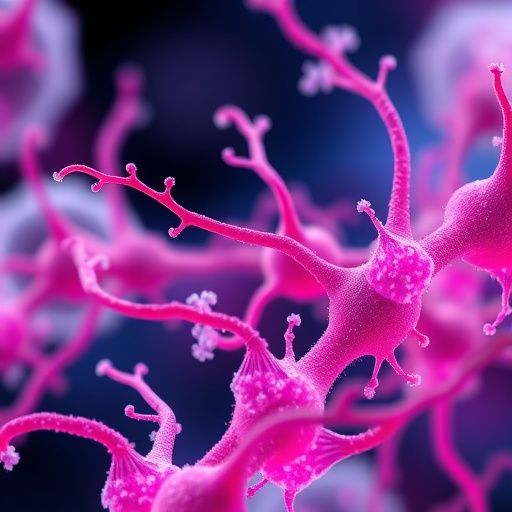The field of vascular medicine is undergoing a transformative shift as research delves deeply into the potential of micro–nanostructures to revolutionize the way vascular stents interact with blood vessel cells. A recent comprehensive study published in BioMedical Engineering OnLine sheds new light on how these ultra-small structures can finely regulate endothelial cells (ECs) and smooth muscle cells (SMCs), opening the door to next-generation stents that promise unprecedented efficacy and biocompatibility.
Vascular occlusive diseases, ranging from acute blockages to chronic arterial narrowing, represent a leading cause of morbidity and mortality worldwide. The deployment of vascular stents has long stood as a frontline therapeutic approach to restore blood flow within narrowed or obstructed vessels. Yet, despite advancements, the current landscape remains burdened by recurrent complications such as “intravascular restenosis,” where excessive smooth muscle cell proliferation narrows the vessel again, and delayed endothelial recovery that compromises vessel healing.
Drug-eluting stents (DES) emerged as a milestone in stent technology, incorporating pharmacological agents to suppress neointimal hyperplasia primarily driven by SMCs. However, these drugs, while effective in restraining smooth muscle proliferation, often exhibit non-selective cytotoxicity. This drawbacks leads to a pronounced delay in endothelialization, a critical process for vascular healing and thrombosis prevention, thus paradoxically increasing the risk of late stent thrombosis.
Amid these challenges, micro–nanostructures — engineered surfaces featuring dimensions at the micro- and nanometer scales — have attracted intense research focus. These structures offer a paradigm shift as they can selectively influence cell behaviors through their physical topography and surface chemistry without relying on drugs. By creating micro- and nano-scale patterns, stent surfaces can be “tuned” to promote EC adhesion, migration, and proliferation, while simultaneously inhibiting SMC growth, thus achieving a dual functional effect.
The study meticulously reviews the diverse fabrication techniques employed to create micro–nanostructures on stent surfaces. These methods range from electron-beam lithography and nanoimprint lithography to anodization and plasma etching. Each technique offers distinct advantages in terms of precision, scalability, and material compatibility. The capacity to control structural parameters such as ridge width, groove depth, and spatial arrangement is crucial, as these influence the mechanotransduction pathways through which vascular cells sense and respond to their substrates.
Evaluating the cellular response to these engineered surfaces involves a multitude of sophisticated detection methods. Fluorescent staining, scanning electron microscopy, and atomic force microscopy provide insights into cell morphology and adhesion characteristics, whereas gene expression assays and protein-level analyses unravel the signaling mechanisms triggered by topographical cues. This comprehensive approach allows researchers to dissect how ECs and SMCs distinctly perceive and react to micro–nanostructures at both the molecular and functional levels.
One of the striking revelations from these investigations is the dimensional specificity of cellular responses. For instance, nanoscale grooves often align endothelial cells along the flow direction, mimicking native vascular architecture and enhancing barrier function. Conversely, certain micron-scale features can disrupt SMC spreading and proliferation, likely by interfering with focal adhesion formation and cytoskeletal dynamics. This size-dependent selectivity is key for designing stent surfaces that harness the inherent differences in morphology and mechanosensitivity between endothelial and smooth muscle cells.
Delving further into the molecular underpinnings, the study highlights how micro–nanostructures modulate integrin clustering and downstream pathways such as focal adhesion kinase (FAK) signaling, RhoA-mediated cytoskeletal reorganization, and nitric oxide synthase activity in ECs. These pathways collectively drive improved endothelialization, increase anti-inflammatory cytokine production, and sustain an anti-thrombotic environment. In contrast, in SMCs, altered mechanosensing leads to cell cycle arrest and reduced synthetic phenotype transition, thus mitigating hyperplasia.
In addition to cell regulation, micro–nanostructures contribute significantly to the overall hemocompatibility of stent materials. By minimizing platelet adhesion and activation through optimal surface roughness and chemical functionalization synergized with topography, these surfaces reduce thrombus formation risk. This multifaceted approach combining biomechanical and biochemical cues represents a holistic strategy to tackle major vascular stenting complications.
Looking ahead, the integration of micro–nanostructures with bioresorbable stent platforms and smart drug delivery systems holds immense promise. As researchers continue to refine fabrication techniques and deepen the mechanistic understanding, the vision of “cell-selective” stents that seamlessly orchestrate vascular repair without pharmacological side effects grows closer to clinical reality.
In essence, the micro–nanostructure approach to vascular stent design signifies a cutting-edge convergence of material science, cellular biology, and clinical medicine. By harnessing the intrinsic differences between endothelial and smooth muscle cells in their response to nano- and micro-topographies, these innovations could transform cardiovascular therapeutics, marking a remarkable stride away from pharmacological dependency towards engineered biological precision.
The study published by Liu, Yan, Gao, and colleagues stands as a seminal contribution, elucidating the preparation methodologies, detection techniques, and functional implications of micro–nanostructured surfaces. As the field evolves, these insights will underpin the development of “smart” vascular implants that achieve rapid endothelialization alongside long-term inhibition of restenosis, a breakthrough eagerly awaited in the battle against vascular occlusive diseases.
Subject of Research: Regulation of endothelial cells and smooth muscle cells through micro–nanostructured surfaces for vascular stent applications
Article Title: Research progress in the regulation of endothelial cells and smooth muscle cells using a micro–nanostructure
Article References: Liu, S., Yan, J., Gao, M. et al. Research progress in the regulation of endothelial cells and smooth muscle cells using a micro–nanostructure. BioMed Eng OnLine 24, 6 (2025). https://doi.org/10.1186/s12938-025-01337-0
Image Credits: Scienmag.com
DOI: https://doi.org/10.1186/s12938-025-01337-0
Keywords: Vascular stents, micro–nanostructure, endothelial cells, smooth muscle cells, restenosis, endothelialization, drug-eluting stents, surface topography, cell regulation, mechanotransduction
Tags: biocompatibility of stentsdrug-eluting stents advancementsendothelial cell regulationendothelialization process in stentinginnovative stent design solutionsintravascular restenosis challengesmicro-nanostructures in vascular medicinenext-generation vascular stentssmooth muscle cell proliferationthrombosis prevention technologiesvascular healing strategiesvascular occlusive diseases treatment





